Open Flame Christiania & Argand Incandescent & Superheated
Choose the element of ‘Lighting – Burners’ above to link directly to that page after reading the introduction below.
Introduction to Burners.
The development of the gas burner is the very first step in the practical use of gas. Before the burner, gas released from any natural source occasionally caught fire – perhaps from a spark or lightning. These natural “fire wells” as they were known could often burn for a very long time and there is a well known picture of Thomas Shirley musing over one of these ‘fire wells’ back in 1659. This is of course ‘natural gas’ formed by the action of rotting vegetation and which, many years later, would result in the revolution of the Gas Industry as it converted from ‘Town Gas’ manufactured from coal to ‘Natural Gas’ brought up from below the north sea. The story goes that the Chinese used the gas from these fire wells, collected in an animal bladder, as a means of mobile lighting, by piercing holes through which the gas escaped and could be lit. The first ‘burner’?
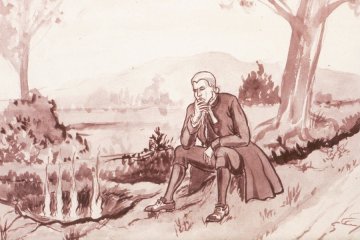
Thomas Shirley Musing over a natural ‘fire well’ in 1659
150 years after Thomas Shirley, the small amounts of gas then manufactured from coal were simply burned through a hole or series of holes in a pipe.
This type of burner, developed steadily for both interior fixtures and street lighting, is known generally as an ‘Open Flame‘ burner and included in this section are the many improvements and later developments of the open flame such as ‘Governor Burners’. Some demonstration sets that have come to light are also included here as are some details on the production of Steatite jets and other items made from this material.
The ‘Christiania and Argand‘ burners, are significant William Sugg developments of the open flame burner, long pre-dating the gas mantle.
‘Incandescent & Superheated‘ burners heralds the advent of the gas mantle – a development that changed the whole lighting industry.
‘High pressure incandescent burners and mantles.’ The advent of the incandescent mantle proved to be another challenge to William Sugg! Whilst accepting the new system he also set out to improve it and soon discovered that by increasing the pressure of the gas supply, the performance could be increased substantially. This section has been added more recently in 2023 as more information has ‘come to light’! Follow the link.
‘Burner Clockwork Time Controllers’ provides an introduction to the means of switching and lighting the gas burners automatically to finally replace the ‘lamplighter’.
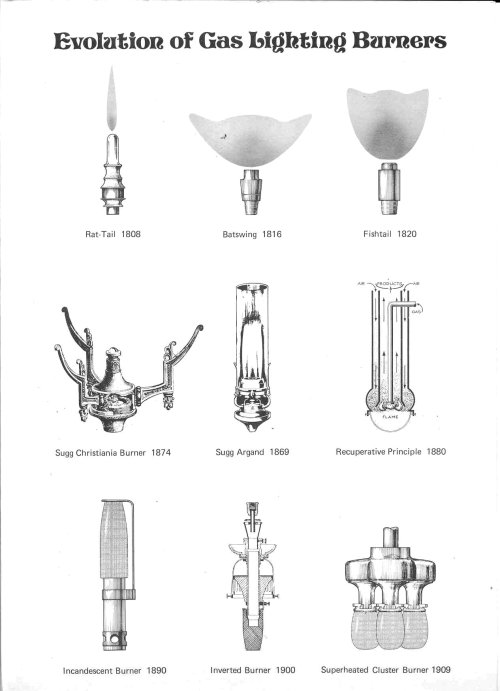
The trays below show a collection of burners and some other items presented to The Museum of London by The Company about the time of the takeover. They were last seen and photographed by CS around 1980.
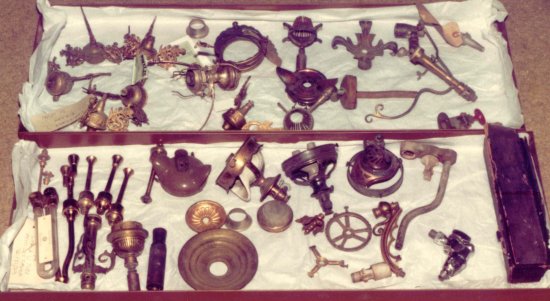
Tray 1 above and below (reversed)
Christiania, Argand, Governor and Inverted burners, Galleries, ‘U’ gauge, Suggflex cock, sectioned floor tap and 2 unidentified burners with tapering rods.
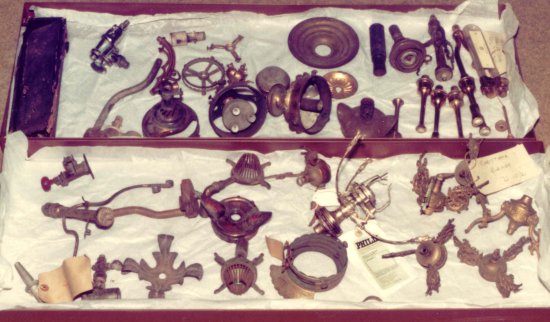
Tray 2, below.
Christiania support arms, Argand, Upright mantle & Upright open flame burners.

Tray 3, below
Exeter, Cromartie, Argand, Upright & Inverted burners and an unidentified burner, centre bottom.
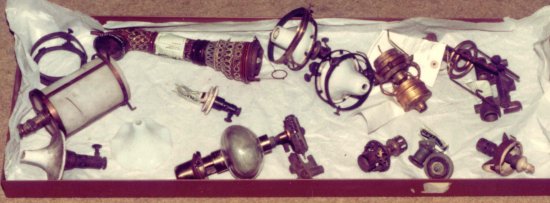
Tray 4, below
Superheated burners, Nozzles & 2 unidentified Inverted burners.
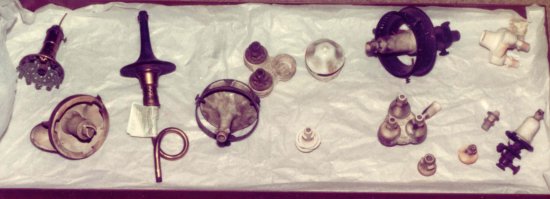
Stuart Hall who was brought up in Dartford, Kent, was given the hand bill below many years ago. As you can see it goes right back to the 1840’s and has the scale of charges for Argand, Batswing, Fish Tail, Single Jet or Pipe Light. Indeed it shows that a 12 hole Argand is charged at the same rate as a Batswing. These charges are for the use of these burners annually. It says at 5 that the Service Pipe will be laid, the internal fittings done, and meters supplied at the expence sic of the consumer, under the direction of the Company’s manager. It is not clear if the consumer has to pay for the actual fixtures themselves. The charge for gas taken by meter is not given although there is a space to fill in the figure.
As you can see the gas company realised how easily a customer could take more gas than they had agreed to and stated that upon a breach of any of their regulations may without notice discontinue the supply of gas and compel the party to make good the damage or loss.
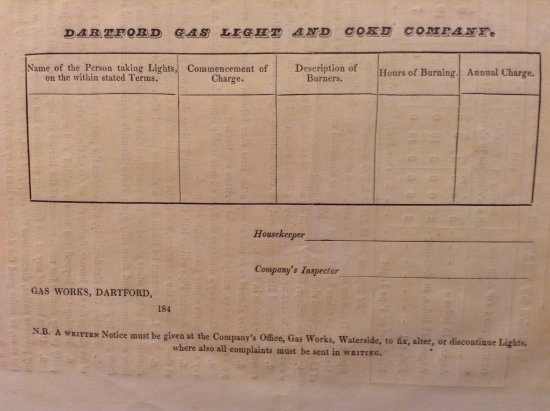
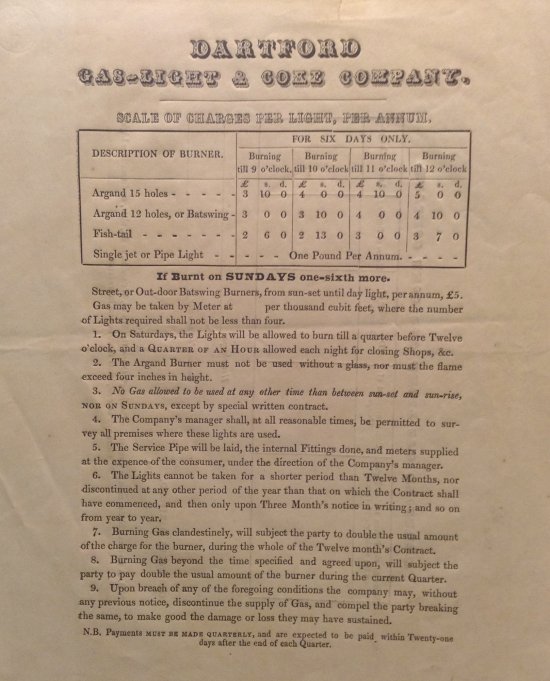
Copyright © Chris Sugg 2006-13

8 responses
I have a 1900 house in Cheshire and in my cellar I have a few very good condition veritas gas burners that seem to be both wall and ceiling mounted. I wondered what their age was and if anyone was interested in them. They are in very good condition.
Hello Stuart P, I may be able to give you a bit more information if you send me a few photos. Are these whole gas brackets or pendants or just the burners? Veritas made burners that were fitted to brackets made by many people and they also made complete fixtures. If they are a collection of fittings it is likely they were removed from the house when the lighting was upgraded. Gas lighting was used for many years, still being common in the 1950’s. Send the pictures to ch***@*******************co.uk and I will see what I can tell you.
Please if you still have a production line, can i have your present gas lit,and mantel lit lights as preference, or indeed if now electric conversion, Catalogue, and price list.
Thanking you, from a passd customer of the 1980.
C/o The Chantry, Hay Lane, Plaidy, Looe Cornwall. PL13.1LF.
Main reply is with your second enquiry below. Sugg Lighting was sold but still operates from Horsham and has a nice website under Sugg Lighting Ltd.
I have a gas burner and which i believe is mantle type street light burner and would like more info on this. It has a single small bore pipe which is open to the gas even when the gas cock is closed, is this pilot light?
Hello Neil,
Send me a picture and I will let you know: ch***@*******************co.uk
After I originally commented I seem to have clicked on the -Notify me
when new comments are added- checkbox and from now on each
time a comment is added I get four emails with the same comment.
Perhaps there is a means you are able to remove me from that service?
Thanks a lot!
Sorry, this is nothing I have any control over – so far as I know!